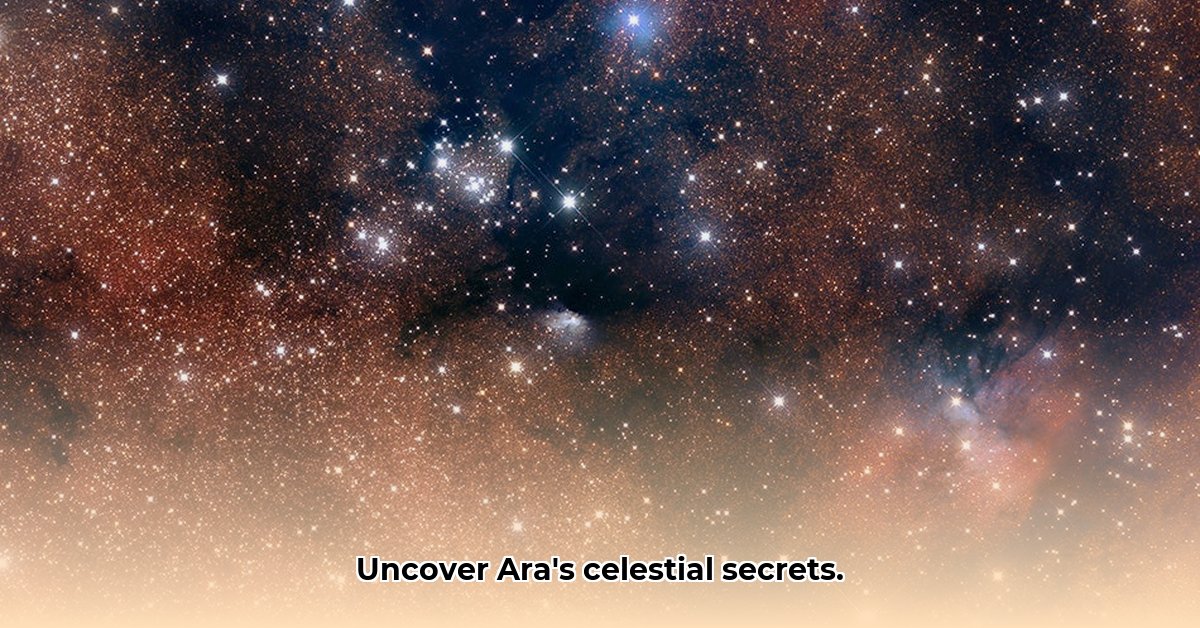
Unveiling the Altar: Delving into Ara's Mythology
Ara, Latin for "altar," holds a prominent place in celestial mythology. Greek legends often link Ara to Zeus, the king of the gods, portraying it as an altar where he offered sacrifices. Another compelling narrative connects Ara to the ill-fated King Lycaon, whose hubris allegedly led to divine retribution, symbolized by this celestial altar. These ancient tales, passed down through centuries, beautifully intertwine with our contemporary scientific understanding, enriching our exploration of the cosmos. How do these ancient myths influence our perception of this constellation's celestial wonders? For more on Ara's mythological background, check out this detailed guide.
Celestial Treasures: Exploring Ara's Deep Sky Marvels
Ara isn't merely a constellation; it's a rich tapestry of deep-sky objects. Globular clusters, majestic gatherings of hundreds of thousands of stars tightly bound by gravity, dominate this region. NGC 6397 and NGC 6352 are prime examples, offering a mesmerizing glimpse into the early universe—ancient stellar cities teeming with untold stories. What secrets do these cosmic metropolises hold?
Beyond the clusters, Ara harbors galaxies—vast, swirling islands of billions of stars, gas, and dust, light-years away. Some are relatively bright, accessible even to amateur astronomers with modest equipment. Witnessing these galaxies is akin to peering into other universes, potentially harboring countless worlds.
And then there are the nebulae, celestial nurseries where stars are born. The emission nebula NGC 6188 is a spectacular example, a vibrant tapestry of gas and dust where stars ignite, radiating color and power. Observing these nebulae provides a front-row seat to the cosmic drama of star formation. What can the vibrant colors and intricate structures of NGC 6188 tell us about stellar birth?
Here's a summary of some key deep-sky objects in Ara:
| Object Name | Type | Apparent Magnitude | Notes |
|---|---|---|---|
| NGC 6397 | Globular Cluster | 5.17 | One of the closest globular clusters; relatively bright and easy to spot. |
| NGC 6352 | Globular Cluster | 8.6 | Fainter; larger telescope recommended. |
| NGC 6215 | Galaxy | 11.2 | Requires a larger telescope for optimal viewing. |
| NGC 6188 | Emission Nebula | Varies | Known for its vibrant colors and intricate detail; a stunning sight. |
Your Personal Ara Observing Guide: A Step-by-Step Journey
Ready to explore Ara's wonders firsthand? This guide will help you locate and observe these celestial treasures:
Locate Ara: Use star charts (printed or digital) to identify Ara's brightest stars. Its proximity to other constellations like Triangulum Australe can aid in its location.
Choose Your Equipment: Binoculars are an excellent starting point for brighter objects. For fainter objects and greater detail, a telescope is required. Larger aperture telescopes provide better light-gathering ability.
Timing is Crucial: Dark skies are paramount. Observe during moonless nights and escape areas with significant light pollution; the darker the better. Do you know the optimal time to view Ara based on its location and your observing site?
Patience and Persistence: Deep-sky objects are often faint. Allow your eyes to adjust to the darkness and give yourself time to discern the subtle details. What techniques do experienced astronomers use to enhance their ability to discern faint details in the night sky?
Record Your Findings: Keep a journal, noting details, brightness, and shapes. Photography enhances the experience and provides a lasting record of your observations.
How to Photograph NGC 6397 in Ara Constellation
Photographing NGC 6397 demands careful planning and execution. This globular cluster, while relatively bright at magnitude 5.17, requires specific techniques to capture its beauty. Its southern declination favors Southern Hemisphere observers. Success hinges on proper equipment, careful planning, and adept image processing. What makes NGC 6397 a particularly rewarding target for astrophotography?
Observational Challenges and Tips
Observing Ara presents some challenges. Light pollution significantly hinders visibility; dark skies are essential. Ara's southern declination makes it more difficult to observe from the Northern Hemisphere. The inherent faintness of deep-sky objects requires long exposure times for proper observation and photography. What strategies help mitigate the effects of light pollution when observing deep-sky objects?